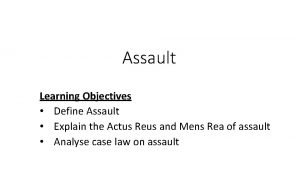Air Assault Operations Purpose The purpose of this





























- Slides: 29


Air Assault Operations

Purpose The purpose of this brief is to teach/re-familiarize leaders with Air Assault planning TTPs and fundamentals. * BNs are the lowest level that can resource an AASLT, but the contemporary operating environment may require a squad to conduct an operation as part of a QRF, TCP establishment, etc.

References FM 90 -4, AASLT Operations Gold Book, 101 st ABN Division (AASLT) 101 st Airborne (AASLT) Leaders Training Program

Agenda Definitions Five Stages of an Air Assault Ground Tactical Plan Landing Plan Air Movement Plan Loading Plan Staging Plan Summary Questions

Air Assault Tenets Integration of assault forces and helicopter assets Maneuver under the control of the ground or air commander Engage and destroy enemy forces To seize and hold key terrain Deliberate, precisely planned, vigorously executed Allow friendly forces to strike over extended distances Attack the enemy when and where he is most vulnerable

Air Movement Tenets Operations other than AASLTS – many of the same facets, but not an ASLT Move troops and equipment Emplace artillery pieces and ADA systems Transport ammo, fuel, and supplies Large scale operations still require detailed planning Aviation is not task-organized but are released to return to their parent units upon mission completion

Definitions AATFC – AASLT TF commander (guy overall in charge of the operation) AMC – air mission commander, usually an aviation commander (ATK or LIFT Battalion CDR) GTC – ground tactical commander (guy on the ground) AMCM – air mission coordination meeting, initial AASLT COA AMB – air mission brief, OPORD for AASLT, PZ to LZ FARP – forward rearming and refueling point, aircraft CSS location DART – downed aircraft recovery team SEAD – suppression of enemy air defense Tadpole Diagram – describes lift compositions ALNO – aviation officer, aviation officer at BDE to plan Bump Plan – if an aircraft cannot fly, the leader’s new load plan for getting mission essential personnel to the fight

Lift/Serial/Load

Five Stages of an AASLT Ground Tactical Plan (GTP) – Drives the AASLT; all other considerations are subordinate to placing forces where they need to be to fight the way they need to fight. Landing Plan Air Movement Plan Loading Plan Staging Plan

AIR ASSAULT PLANNING METHODOLOGY STAGING PLAN LOADING PLAN AIR MOVEMENT PLAN LANDING PLAN GROUND TACTICAL PLANNING LP 1 CAA ASSY AREA CAA PZ LZ LP 2 LP 3 PZ LZ LP 4 EXECUTION RECON SECURITY GUIDES C 2 SEQUENCE ESTIMATE BACKWARDS PLAN REHEARSALS (W/WO ACF) PZ SELECTION PZ CONTROL PZ C 2 MVMT TABLE BUMP PLAN SEQUENCING PZ POSTURE FLIGHT PLANNING IAW LNO & AMC ROUTES, AXIS SP/RP LOCATIONS C 2 CONTROL MEASURES MVMT TABLE SEAD TIMINGS REFUEL/REARM FLIGHT MODES LZ CONSIDERATIONS SINGLE MULTIPLE SELECTION SECURITY SPTING FIRES ORIENTATION C 2 FORMATION CSS RESUPPLY CASEVAC WHAT HAS CHANGED?

Five Stages of an AASLT Five stages/plans tie together in this way: -GTP drives LZ selection -LZ selection drives the landing plan and air movement plan -Flight routes and current friendly locations dictate the loading plan and PZ locations -Loading plan defines the requirements that become the staging plan -Good GTP takes into account the limitations of LZ’s, aircraft available, routes, etc. to mass combat power at the decisive point

The Ground Tactical Plan Foundation of the AASLT and developed by the GTC IAW doctrine, TTPs, and METT-T. GTP drives LZ selection (false LZs). GTP Components Mission objectives Primary/alternate LZs Task Organization D-day/H-hour times Forces required/available Special equipment required (kick-off bundles) Fire Support Plan (including prep fires) ATK aviation missions (CAS or CCA) Means of identifying LZs Landing formations Offloading Procedures (right/left door exit, assemble en route? ) CASEVAC and CSS issues

The Landing Plan Generally one primary LZ and one alternate LZ per maneuver BN (each serial must be ready to execute at either) Forces must land ready to fight Organize on the PZ, not the LZ Fly and land in the order of march/assault Each serial is able to fight as a team/tactical integrity Provide inbound guidance to a/c both radio and visual Ground forces exit one or both doors (METT-T) Vehicles and ground forces clear LZ quickly * Rehearse off-load during cold load training, which is mandated. Not all of your soldiers have been on a UH-60 or CH-47.

The Landing Plan The landing is a critical component of the AASLT because it is here that forces are most vulnerable so the conditions must be set. Two types of landings driven by METT-T: -Away from the OBJ (MTC) -On the OBJ (raid, FLS seizure, cordon) *There are many considerations for where you land, usually time/enemy sensitive.

The Landing Plan Condition Setting: -Higher level activity, usually BDE level activity -Purpose: Attrition of enemy combat power that can affect the AASLT force Targeting Teams: use of theater assets and organic assets that will assist in the arrival of the AASLT force with risk mitigated (COLTs, AVN assets, SCOUTs) *Understand that “higher” tries to make your landing conditions favorable but it won’t always happen.

The Landing Plan Grid: GL 12345678 Land Heading: 0 degrees Marking: IR Strobe Left Door Exit AVN Call sign: Hardcore 6 Door Gunner instructions Distance/Direction to OBJ NFA locations IRF OBJ *Ranking man on a/c or chalk leader should be on the ‘dog bone’ and listen for a cherry or ice call. *Who gets off first—LTC Hal Moore’s efforts were motivational but were they necessarily smart? Wharton LZ N

Situational Awareness Hot LZ procedures – battle drills Critical from PZ to LZ Where are we during flight? When will we land? What’s waiting for me at the LZ? Ground element/chalk leader has responsibility from PZ to LZ Required Items to have or know: Marked air route map Compass PLUGR or Garmin Commo card Air Movement table, tadpole diagram, PZ/LZ sketch FM radio Location of friendly forces in OBJ area *Where Murphy pops up - the helicopter won’t always drop you in the correct location, GPS can’t track on board, too much metal to verify helicopter’s land heading on your compass.

The Air Movement Plan Flight operation from PZ to LZ and return Air Mission Commander (AMC) receives all Army aviation forces and enroute fires to include initiation of LZ preparatory fires. One-way flight routes and air corridors are utilized. Air Movement Table is the base document for the plan: A/C locations # and type of a/c in each serial Departure point, route to and from loading area and, lift-off and landing times

Flight Route Example

Air Movement Table Example

The Loading Plan Based on the Air Movement Plan Ensures that troops, equipment and supplies are loaded on the correct aircraft Aircraft loads are placed in priority to establish a bump plan Planning must cover: Organization and operation of the PZ Load positions Day and night markings Communications *Loading plan knowledge critical when mixing internal and external loads or when mixing aircraft types. *Additionally, the leader must identify who will fly on which aircraft, i. e. you don’t want to have all of your mortar tubes, MGs, key leaders on one a/c…must sync with GTP.

Situational Awareness Chalk Leader Responsibilities: -Usually an E-5/E-6 -Provides copies of manifest (1 x himself, 1 SG, crew chief/pilot, PZ checkin) -Rehearses cold load training and instructs personnel on how to correctly load/unload aircraft (UH-60 s, 90 degrees from the side/CH-47 s, 45 degrees from the rear) -Monitors radio during flight -Tracks all aerial checkpoints IOT verify location upon landing -Ensures personnel prepared to dismount the helicopter NLT five minutes out -Echoes execute command to exit aircraft

The Loading Plan Chalk Card – 3 x 5 card Front PZ Name LZ Grid w/same datum as used by a/c ALT LZ grid Lift Serial Chalk OBJ Name Back Full Name 1. 2. 3. 4. 5. 6. 7. 8. No Bump Chalk LDR 3 rd PL Breach Kit

Bump Plan Ensures critical men and equipment are loaded on aircraft should mechanical or other problems limit planned air resources. Each aircraft in a serial must have a bump priority and each soldier on a chalk must have bump priority. If an aircraft on the PZ can not lift off and key personnel are on board, they will offload and reload another aircraft that has priority.

Staging Plan Based on the Loading Plan and prescribes the arrival time of ground units (troops, equipment and supplies) at the PZ in the proper order of movement Loads must be ready before aircraft arrive at the PZ Ground units usually expected in PZ posture 15 minutes before aircraft arrives Restates PZ organization, defines flight routes to the PZ and provides instructions for air link-up. * Staging Plan may also follow the Ground Tactical Plan as part of a planned withdrawal.

Sub-unit Responsibilities Send chalk leaders to PZ orientation if applicable PAX/vehicle must know lift #, serial #, chalk #, LZ Vehicles rigged by air assault qualified personnel Use internal communications on the PZs Identify chalk leaders and signalmen early in planning process

Summary Five Stages to AASLT: Ground Tactical Plan, Landing Plan, Air Movement Plan, Loading Plan, Staging Plan Leaders must incorporate time to rehearse loading and landing aircraft – introduce contingencies into these rehearsals Quickly move off of LZs and maintain security in PZ posture at all times Principles for air movement operations are similar to air assault operations

Questions?
 Tadpole diagram air assault
Tadpole diagram air assault Hubungan air tanah dan tanaman
Hubungan air tanah dan tanaman Wichita area sexual assault center
Wichita area sexual assault center Battery mens rea
Battery mens rea Assault vs battery examples
Assault vs battery examples Professor robert allison
Professor robert allison Sexual assault expert witness
Sexual assault expert witness Assault vs battery
Assault vs battery Tca 39-13-111
Tca 39-13-111 Assault position
Assault position Indecent assault ordinance
Indecent assault ordinance The assault cycle is used to
The assault cycle is used to Actual bodily harm
Actual bodily harm Isrr icd 10
Isrr icd 10 Koko the gorilla sexual assault
Koko the gorilla sexual assault Composite air operations
Composite air operations Hát kết hợp bộ gõ cơ thể
Hát kết hợp bộ gõ cơ thể Lp html
Lp html Bổ thể
Bổ thể Tỉ lệ cơ thể trẻ em
Tỉ lệ cơ thể trẻ em Voi kéo gỗ như thế nào
Voi kéo gỗ như thế nào Chụp phim tư thế worms-breton
Chụp phim tư thế worms-breton Chúa yêu trần thế alleluia
Chúa yêu trần thế alleluia Kể tên các môn thể thao
Kể tên các môn thể thao Thế nào là hệ số cao nhất
Thế nào là hệ số cao nhất Các châu lục và đại dương trên thế giới
Các châu lục và đại dương trên thế giới Công thức tiính động năng
Công thức tiính động năng Trời xanh đây là của chúng ta thể thơ
Trời xanh đây là của chúng ta thể thơ Mật thư tọa độ 5x5
Mật thư tọa độ 5x5 Phép trừ bù
Phép trừ bù




















































